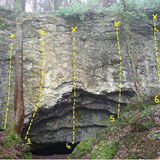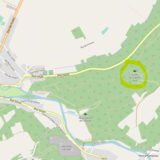⛔️ Climbing here is not allowed. ⛔️
Climbing has been tolerated here for decades, but no longer is. Please respect this closure to protect nature and for a potential future regularisation of the crag. Wandering in the forest of the trails is not allowed either. Please stay on the trails.
The topos are only available for historic reference.
🇬🇧
This is a small vertical face of just 5-7m high which offers some very fingery climbing.
It's situated in the forest, making it a shady place suitable to spend time on the hotter days of the year. Forget about climbing here in winter. At the base of the crag, you fin the entrance to the neolithic cave "la Porte Aïve".
Please, don't climb in the cave! It is a préhistoric site!!! Climbing is "Tolerated", so pay extra attention.
Due to the limited height and the historic value of the place, the routes are only climbable as Top Rope. You can access the anchor (1 bolt only) by abseiling from a tree above the crag. Another option is to bring your crashpads, but it's on the high end for that... If you boulder and top out, take care because the top 30cm of rock are of bad quality.
🇫🇷
C’est une petite barre verticale de 5 à 7 mètres de haut qui offre une escalade très à
doigts. Elle est située dans les bois, à l’abri du soleil, et est donc idéale lors de fortes
chaleurs. Grimpe en hiver impossible. A la base du massif se trouve l’entrée de la grotte néolithique de la Porte Aïve.
Surtout ne pas grimper à l’intérieur de la grotte: site préhistorique !!! Escalade tolérée !
Vu la faible hauteur du rocher et la « sensibilité » de l’endroit (grotte néolithique), les
voies se grimpent en moulinette. Une broche a été placée au sommet de chaque voie.
On y accède via un rappel sur un arbre au dessus du massif. Une autre possibilité est
de grimper style « bloc ». Possible mais assez foireux car les derniers 30cm de sortie
sont délités.



